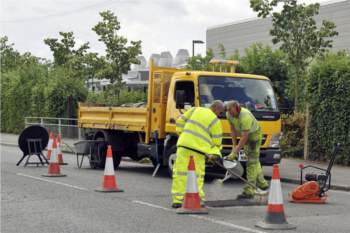New research from the RAC has revealed a doubling in the proportion of its pothole-related call-outs in a decade, despite major improvements in the last year.
A study from the motoring organisation compared the percentage share of pothole-related breakdowns to all other types of call-out, alongside historic weather data.
It revealed an increase of 125% from 2006 to 2016 in the proportion of vehicle breakdowns where poor road surfaces were likely to be a contributory factor, such as damaged shock absorbers, broken suspension springs and distorted wheels.
However the share of pothole-related breakdowns for the second quarter of 2016 does show a 40% reduction compared with the second quarter of 2015 (1.5% to 0.9%)

Councils 'fix one pothole every 15 seconds'
In the 12 months ending in June 2006, pothole-related breakdowns represented an average of 0.4% of all RAC call-outs, a figure that rose to 0.9% for the year to June 2016. The RAC said its pothole analysis showed ‘a striking rise in pothole call-outs’ – from 0.5% to 1.1% – between 2007 and 2009.
RAC chief engineer David Bizley said: ‘While it’s good news that the share of pothole-related breakdowns for the second quarter of 2016 does show a 40% reduction compared with the second quarter of 2015 (1.5% to 0.9%) we need to see further reductions before we can be confident that we really are improving the underlying quality of roads, and not just repairing damage from the most recent adverse weather.’
Mr Bizley praised the Government for taking ‘bold steps’ to ensure that the strategic road network in England is fit for purpose and capable of supporting economic growth, but added: ‘However, the majority of the damage our members have suffered has been when using local roads.’
'It is clear that the effects of insufficient investment over much of the last decade are going to take some considerable time to rectify. Most journeys start or finish on local roads even if the bulk of the mileage is on the strategic road network, or by rail, sea or air. Without local roads that are fit for purpose, the benefits of the Government’s bold investment in national transport infrastructure may never be fully realised.'
Cllr Peter Box, transport spokesman for the Local Government Association, said: ‘Local authorities are hamstrung by a huge disparity in funding. The Government has earmarked more than 40 times less money for local roads, which councils look after, compared to motorways and main roads.
‘Councils face a £12bn backlog of road repairs which would already take more than a decade to clear. Current funding levels mean councils are only able to keep pace with patching up our roads and filling potholes rather than carrying out more cost-effective and long-term improvements.’
Register now for full access
Register just once to get unrestricted, real-time coverage of the issues and challenges facing UK transport and highways engineers.
Full website content includes the latest news, exclusive commentary from leading industry figures and detailed topical analysis of the highways, transportation, environment and place-shaping sectors.
Use the link below to register your details for full, free access.
Already a registered? Login